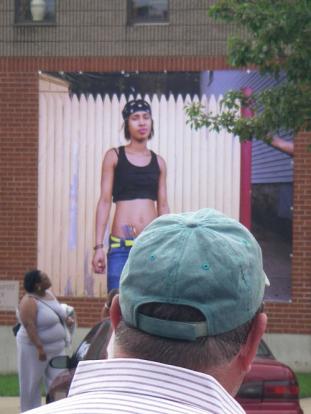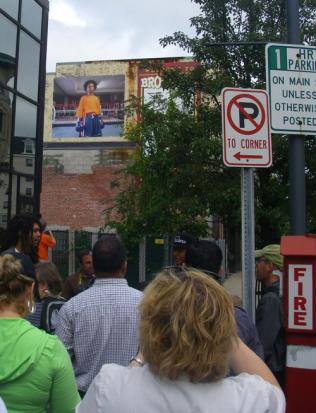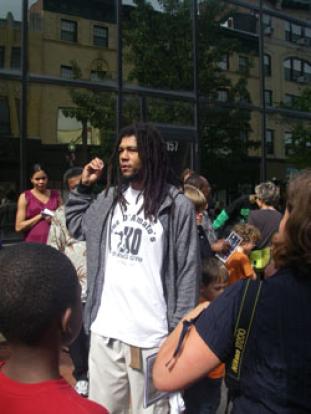I visited Mary Beth Meehan’s City of Champions, a display of large-scale images of Brockton residents on the walls of buildings in downtown Brockton. Meehan photographs people she gets to know and comes across in Brockton, a town that is struggling with economic hardship, a changing population, and a growing rift between “old” and “new” Brockton, a rift that is at least partially racial.
The images will be up for a year, and the project also includes various kinds of participatory programming, a project web site, and newspaper articles. Mary Beth Meehan wrote a couple of articles about her project including one for the Public Humanist, and it has received local publicity. Many of the articles include slideshows, which feature photos that are now large-scale banners hanging on buildings in Brockton and others which are part of the larger project, which is explained on Meehan’s own web site.
The project also received a nice spread in the Globe, so I won’t bother you with a full report, save it to say that there were 100 or so people there, and that the premise —mounting good, provocative, billboard sized photos on buildings downtown gets people to think and talk about them–seems to work.
For sure, the images are kicking up some dust around the question of “how does Brockton look in the hands of Mary Beth Meehan,” “did she get it right,” or, “is this what we want the world to know about Brockton?” Meehan, however, wasn’t sure that the talk was the kind of talk she was hoping to inspire, and the question must be asked: Can she get people to actually look at each other and imagine each other’s hopes and dreams? Will they replace nostalgia for a clearer time with the images of a new, struggling, Brockton along with an older, settled, successful working class city? And that is what I would like to talk about: how these photos do their work in our intensely visual culture.
The Brockton of Meehan’s youth, she explained, was one that was sure about itself and is reflected in images of people who know who they are and who know what their place is in society: police officers at inauguration day, a political meeting with a bucolic Irish backdrop, an elderly woman in her well-appointed dining room; an old man walking into a yard dominated by a swimming pool, decorated for July Fourth. That last image was the America I immigrated into: a working class that had done well enough to become middle class, where life was centered on the children the pool was for.
Meehan herself grew up in this world and she wishes, she says, that everyone could have such a secure youth. Maybe, if you were a child. But if you were a grown-up? The “old Brockton” photos exude a mild sense of celebration and loss, but, image by image, they are not nearly as strong as the photos of “new Brockton.” Without the other half (a strong American photographic tradition that runs the gamut from Jacob Riis to Robert Frank, both undoubtedly influences on Meehan) the project would be unremarkable. With them, the whiteness and sameness becomes jarring, not of today, a harking back to an oppressive culture of conformity: be part of the group, be in the kitchen, vote Irish. You can’t see the limitations of old Brockton without contrasting it with the new.

And what about those new images? They include a defiant-looking young woman posing in front of a fence whose image is stuck on a church wall, and, mounted lower than most, an undocumented immigrant hiding under a fleece blanket printed with the American flag. Mary Beth knew of course that posting a picture of a person with the flag on his face would be controversial. “He looks sick!” said one city official. “Are you trying to say that all immigrants in Brockton are sick?” Another comment on these pictures, “By showcasing this picture you are throwing salt in the wounds of Brockton!”
What makes these images controversial? There are others of people of color that are not controversial, so it isn’t simply about “there are non-white people here.” We are continuously inundated with strong visuals, good and bad. With “strong” I mean full of effect: things flash by, they are bright, large, they move at you. In your face is the modus operandi of much moving and not moving imagery, often accompanied by in your ear. A certain ennui factor plays a role in the prevalence of ever faster, more visually challenging nature of imagery: we have easily “seen it all.” In a world of bombs blowing up people at our dinner table, how does a portrait on the wall of a parking garage stack up?
You would think all that exposure to images makes us sophisticated: we have learned how to look, we are not easily swayed by what in the past might have been stunning simply in its richness. And in some ways we have evolved as viewers, for instance, in the power of color photography to convey what is “reality.” My parents’ childhood photos are black and white and small. I don’t see them as representing a reality I know, even if they are quaint, and cool as photos. A perfectly wonderful Kodachrome would have sufficiently impressed friends and family with the actuality of a 1950’s Hawaii vacation – but by 1973 everything looked “worse in black and white.” What those old photos lacked was verisimilitude, “the look of real,” which is necessary for an image or story to sway us.
By the eighties, however, in a comic reversal, color realism had outdone itself in realism: as black and white became less real, it was seen to represent a more authentic –less plastic – world of the past. Images could gain verisimilitude by looking like the photos that were taken at a time when, we thought, experience was more interesting (probably because the photos looked as if what they depicted was more interesting or significant than contemporary reality. Tautology, anyone?). As Calvin’s father says in the famous cartoon, “In fact, those old photographs are in color, it’s just the world was black and white then.” Paul Simon changed his lyric about black and white from “worse” to “better” by 1981 and whole generations of photographers, of which I am one, worked in black and white in order to gain the grit of art-reality.
But the clarity of digital photography has brought us full circle: large, vivid full-color photos represent the banal realism of our plastic world very well. So well, in fact, that it isn’t interesting to look at in ordinary formats. Hence the nauseatingly ubiquitous Hipstamatic and Instagram software, which tinges a perfectly ordinary image of a Massachusetts sunset (so inured are we to the wonders) with the lurid hippishness of a 1950’s Hawaiian postcard.
Enter Marybeth Meehan and her large-scale full color billboards of Brockton residents.
Where a generation ago her photos might have gained documentary impact from being black and white, today, they get it from the unadorned (though very professional) color photograph blown up gigantically. The photos hit one with large dose of “reality” because they expose up close the way a billboard would: they are not “nice” photos. “I am here” say the people in the photos, “I am real. Deal with me.” Each of these people is not larger than life or part of a group or there as a representative. Each is one person among many, but they are persons in a particular situation, and their place is not comfortable or voluntary, like that of the “old” Brockton residents. And it is this one-for-one relationship with the “real” of these central photos that makes the project work.

So where does that leave Brockton trying to move on from antagonism and defeat? Meehan offers a way out to the future: the project includes a series of photographs that shows ways forward, young people poised to take on the role of Champions. In and of themselves the photos of a young girl with flowers grabbed from City Hall Plaza posed in front of a boarded-up house, a high school marching band musician, and a young man poised to take on the cape of Rocky Marciano could be seen as trite, a cop-out. What isn’t a cop-out, however, is that they remove the option: they force viewers to agree (who could not agree with a boxing champion dressed in his father’s duds?) that there is only one way forward — move beyond polarization of the idealized kitchen versus the scary and possibly sick immigrant, beyond hanging on to the past. If there is to be a future at all, Brocktonites of all stripes have to embrace all of the young people and give them hope. As the boxer’s father said during our tour: “Don’t see a child as the next Rocky Marciano, look for the things that are special in him.”



